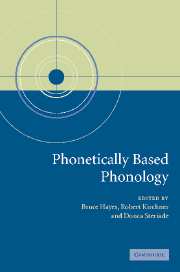Book contents
- Frontmatter
- Contents
- List of contributors
- List of abbreviations
- 1 Introduction: the phonetic bases of phonological Markedness
- 2 A review of perceptual cues and cue robustness
- 3 Place assimilation
- 4 The typology of rounding harmony
- 5 The evolution of metathesis
- 6 The role of contrast-specific and language-specific phonetics in contour tone distribution
- 7 Vowel reduction
- 8 Contrast and perceptual distinctiveness
- 9 Syllable weight
- 10 Consonant lenition
- 11 Language processing and segmental OCP effects
- Index
9 - Syllable weight
Published online by Cambridge University Press: 21 October 2009
- Frontmatter
- Contents
- List of contributors
- List of abbreviations
- 1 Introduction: the phonetic bases of phonological Markedness
- 2 A review of perceptual cues and cue robustness
- 3 Place assimilation
- 4 The typology of rounding harmony
- 5 The evolution of metathesis
- 6 The role of contrast-specific and language-specific phonetics in contour tone distribution
- 7 Vowel reduction
- 8 Contrast and perceptual distinctiveness
- 9 Syllable weight
- 10 Consonant lenition
- 11 Language processing and segmental OCP effects
- Index
Summary
Introduction
The goal of this chapter is to explore the role phonetics plays in shaping the phonology of syllable weight. Standard (moraic and skeletal slot) treatments of weight assume that weight criteria (i.e. what syllables count as ‘heavy’) may vary from language to language, but that all phonological processes within a given language will employ a uniform weight criterion. An extensive survey of weight-sensitive phonological phenomena, however, shows the opposite: weight criteria are frequently non-uniform within a given language, but particular weight criteria are characteristic of particular classes of weight-sensitive phenomena, with considerable cross-linguistic uniformity for those phenomena. This chapter focuses on weight-sensitive stress and tone. I argue that the divergent weight criteria observed in stress and tone systems largely follow from differences in the phonetic implementation of stress and tone. Phonetics also plays a role in accounting for cross-linguistic variation in weight criteria for a given process: such variation is often attributed to independent phonetic properties of these languages, which are in turn grounded in other phonological properties such as syllable structure.
Despite the importance of phonetics, however, syllable weight is not sensitive only to phonetic considerations. I will claim that languages employ weight distinctions that operate over phonologically symmetrical classes of syllables, even if this means not exploiting the phonetically most effective weight distinction(s).
Finally, I will argue that the ingredients of process-specificity of weight criteria, phonetic effectiveness, and phonological simplicity together play a crucial role in the ranking of a set of Optimality-Theoretic constraints governing weight-sensitive phenomena. The divergent phonetic motivations behind different weight-sensitive processes are reflected in process-specific sets of constraints.
- Type
- Chapter
- Information
- Phonetically Based Phonology , pp. 277 - 312Publisher: Cambridge University PressPrint publication year: 2004
- 16
- Cited by

